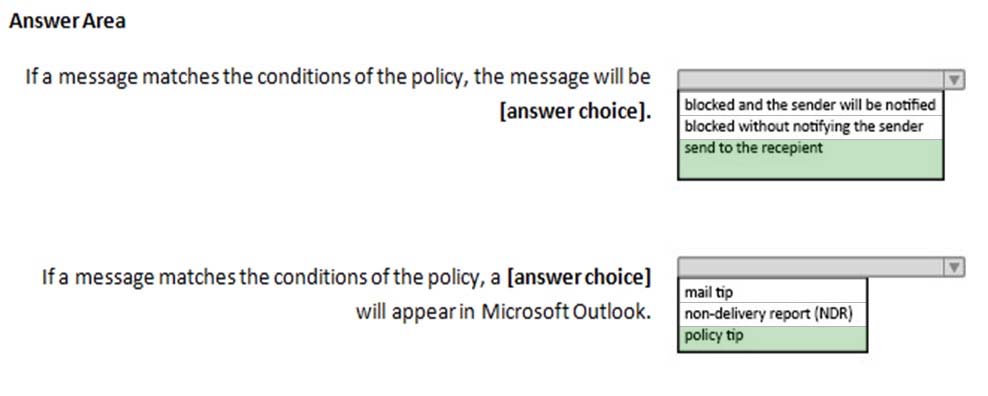Microsoft 70-345 Exam Practice Questions (P. 5)
- Full Access (168 questions)
- Six months of Premium Access
- Access to one million comments
- Seamless ChatGPT Integration
- Ability to download PDF files
- Anki Flashcard files for revision
- No Captcha & No AdSense
- Advanced Exam Configuration
Question #21
HOTSPOT -
You have an Exchange Server 2016 organization. The Active Directory sites are configured as shown in the following graphic.
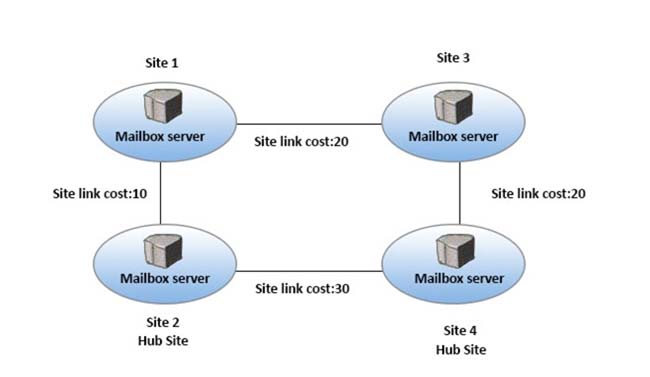
Use the drop-down menus to select the answer choice that completes each statement based on the information presented in the graphic.
Hot Area:

You have an Exchange Server 2016 organization. The Active Directory sites are configured as shown in the following graphic.

Use the drop-down menus to select the answer choice that completes each statement based on the information presented in the graphic.
Hot Area:

Correct Answer:

By default, all site links are transitive. This means that if Site A has a link to Site B, and Site B has a link to Site C, Site A is transitively linked to Site C. The transitive link between Site A and Site C is also known as a site-link bridge. A message sent from Site A to Site C would be sent directly to Site C.
In your Exchange organization, you may want to force all message delivery through a specific Active Directory site. You can use the Shell to designate an Active
Directory site as a hub site. When you do this, you cause additional overall overhead because more servers are involved in message delivery. For example, consider a message that's sent from Site A to Site E. If the least-cost routing path is Site A-Site B-Site C-Site D-Site E, and you designate Site C as a hub site, the message is relayed from Site A to Site C and then relayed from Site C to Site E.
Whenever a hub site exists along the least-cost routing path for message delivery, the messages are queued and are processed by the Transport service on
Mailbox servers in the hub site before they're relayed to their ultimate destination.
After the least-cost routing path is chosen, routing determines whether there's a hub site along that routing path. If a hub site is configured, messages stop at a
Mailbox server in the hub site before they're relayed to the target destination.
References:
https://technet.microsoft.com/en-us/library/jj916681(v=exchg.160).aspx

By default, all site links are transitive. This means that if Site A has a link to Site B, and Site B has a link to Site C, Site A is transitively linked to Site C. The transitive link between Site A and Site C is also known as a site-link bridge. A message sent from Site A to Site C would be sent directly to Site C.
In your Exchange organization, you may want to force all message delivery through a specific Active Directory site. You can use the Shell to designate an Active
Directory site as a hub site. When you do this, you cause additional overall overhead because more servers are involved in message delivery. For example, consider a message that's sent from Site A to Site E. If the least-cost routing path is Site A-Site B-Site C-Site D-Site E, and you designate Site C as a hub site, the message is relayed from Site A to Site C and then relayed from Site C to Site E.
Whenever a hub site exists along the least-cost routing path for message delivery, the messages are queued and are processed by the Transport service on
Mailbox servers in the hub site before they're relayed to their ultimate destination.
After the least-cost routing path is chosen, routing determines whether there's a hub site along that routing path. If a hub site is configured, messages stop at a
Mailbox server in the hub site before they're relayed to the target destination.
References:
https://technet.microsoft.com/en-us/library/jj916681(v=exchg.160).aspx
send
light_mode
delete
Question #22
HOTSPOT -
You have an Exchange Server 2016 organization.
All users use Microsoft Outlook 2016.
You need to configure the Exchange Server organization to meet following requirements:
✑ Users must be prevented from receiving a notification when they attempt to send an email message to distribution groups that contain less than 100 members.
✑ Users must be notified before they send email messages to an unmonitored mailbox named Service1.
Which cmdlet should you run to meet each requirement? To answer, drag appropriate cmdlets to the correct requirements. Each cmdlet must be used once, more than once, or not at all. You may need to drag the split bar between panes or scroll to view content.
: Each correct selection is worth one point.
NOTE -
Hot Area:
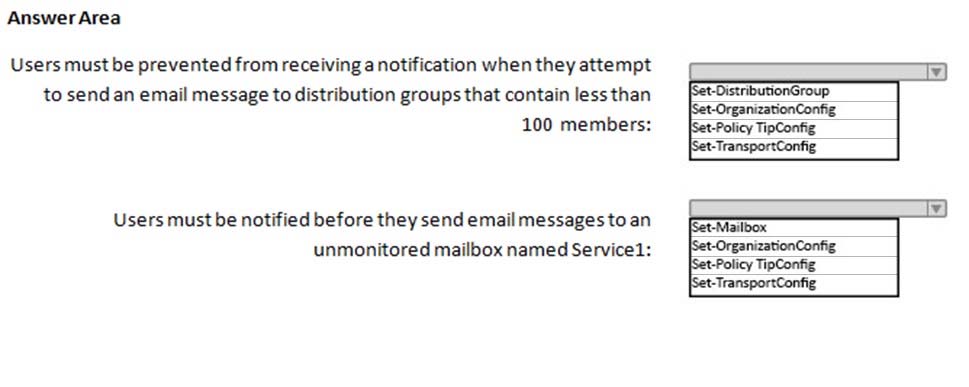
You have an Exchange Server 2016 organization.
All users use Microsoft Outlook 2016.
You need to configure the Exchange Server organization to meet following requirements:
✑ Users must be prevented from receiving a notification when they attempt to send an email message to distribution groups that contain less than 100 members.
✑ Users must be notified before they send email messages to an unmonitored mailbox named Service1.
Which cmdlet should you run to meet each requirement? To answer, drag appropriate cmdlets to the correct requirements. Each cmdlet must be used once, more than once, or not at all. You may need to drag the split bar between panes or scroll to view content.
: Each correct selection is worth one point.
NOTE -
Hot Area:

Correct Answer:
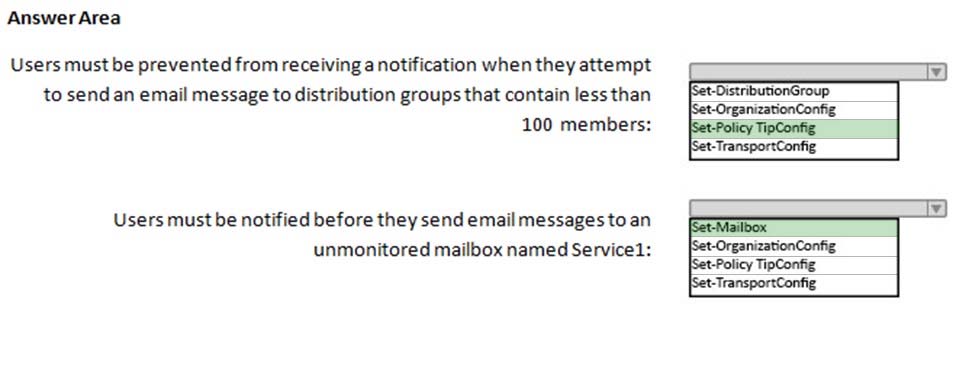
References:
https://technet.microsoft.com/en-us/library/bb123981(v=exchg.160).aspx https://technet.microsoft.com/en-gb/library/jj619307(v=exchg.150).aspx

References:
https://technet.microsoft.com/en-us/library/bb123981(v=exchg.160).aspx https://technet.microsoft.com/en-gb/library/jj619307(v=exchg.150).aspx
send
light_mode
delete
Question #23
DRAG DROP -
Your company has an Exchange Server 2016 organization. The organization contains three servers and 2,000 mailboxes.
The organization audits all access to user mailboxes.
The company's security policy has the following requirements:
✑ Audit the name of each administrator who modifies the Exchange Server organization settings.
✑ Reduce the amount of audit log information generated by a service account named Service1.
✑ Create an audit entry when an administrator modifies the permissions of another administrative mailbox.
You need to identify which PowerShell cmdlets must be used to meet the requirements.
Which PowerShell cmdlet should you identify for each requirement? To answer, drag the appropriate cmdlets to the correct requirements. Each cmdlet may be used once, more than once or not at all. You may need to drag the split bar between panes or scroll to view content.
: Each correct selection is worth one point.
Note -
Select and Place:

Your company has an Exchange Server 2016 organization. The organization contains three servers and 2,000 mailboxes.
The organization audits all access to user mailboxes.
The company's security policy has the following requirements:
✑ Audit the name of each administrator who modifies the Exchange Server organization settings.
✑ Reduce the amount of audit log information generated by a service account named Service1.
✑ Create an audit entry when an administrator modifies the permissions of another administrative mailbox.
You need to identify which PowerShell cmdlets must be used to meet the requirements.
Which PowerShell cmdlet should you identify for each requirement? To answer, drag the appropriate cmdlets to the correct requirements. Each cmdlet may be used once, more than once or not at all. You may need to drag the split bar between panes or scroll to view content.
: Each correct selection is worth one point.
Note -
Select and Place:

Correct Answer:

References:
https://technet.microsoft.com/en-us/library/ff696758(v=exchg.160).aspx https://technet.microsoft.com/en-us/library/dd298169(v=exchg.160).aspx https://technet.microsoft.com/en-us/library/dd335144(v=exchg.160).aspx

References:
https://technet.microsoft.com/en-us/library/ff696758(v=exchg.160).aspx https://technet.microsoft.com/en-us/library/dd298169(v=exchg.160).aspx https://technet.microsoft.com/en-us/library/dd335144(v=exchg.160).aspx
send
light_mode
delete
Question #24
HOTSPOT -
You run the Get-DlpPolicy cmdlet and you receive the following output.
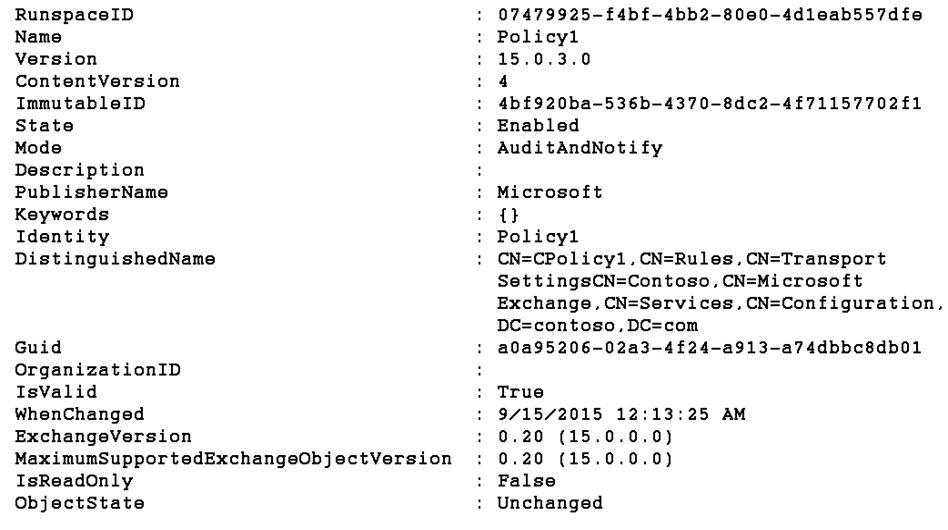
Use the drop-down menus to select the answer choice that completes each statement based on the information presented in the output.
Hot Area:
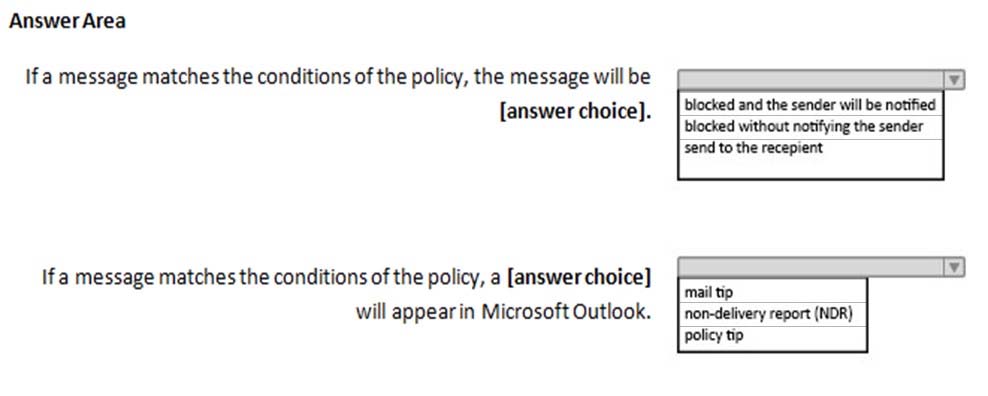
You run the Get-DlpPolicy cmdlet and you receive the following output.

Use the drop-down menus to select the answer choice that completes each statement based on the information presented in the output.
Hot Area:

send
light_mode
delete
Question #25
HOTSPOT -
You have an Exchange Server organization. The organization contains four servers. The servers configured as shown in the following table.
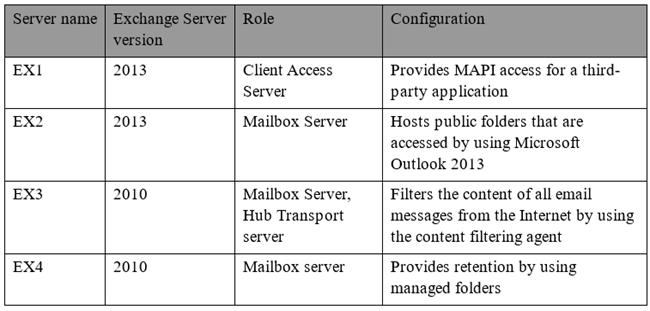
You plan to upgrade the organization to Exchange Server 2016.
You need to identify which servers have functionalities that can be fully achieved by using Exchange Server 2016.
What should you identify? To answer, select the appropriate options in the answer area.
Hot Area:
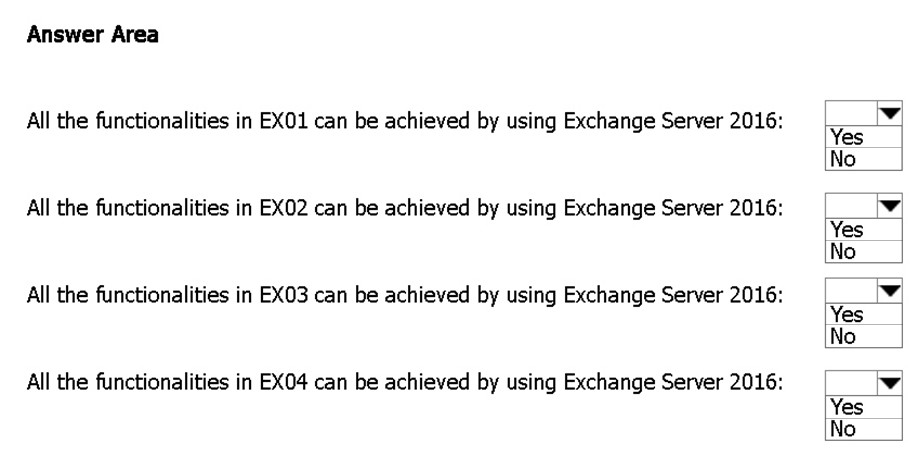
You have an Exchange Server organization. The organization contains four servers. The servers configured as shown in the following table.

You plan to upgrade the organization to Exchange Server 2016.
You need to identify which servers have functionalities that can be fully achieved by using Exchange Server 2016.
What should you identify? To answer, select the appropriate options in the answer area.
Hot Area:

Correct Answer:
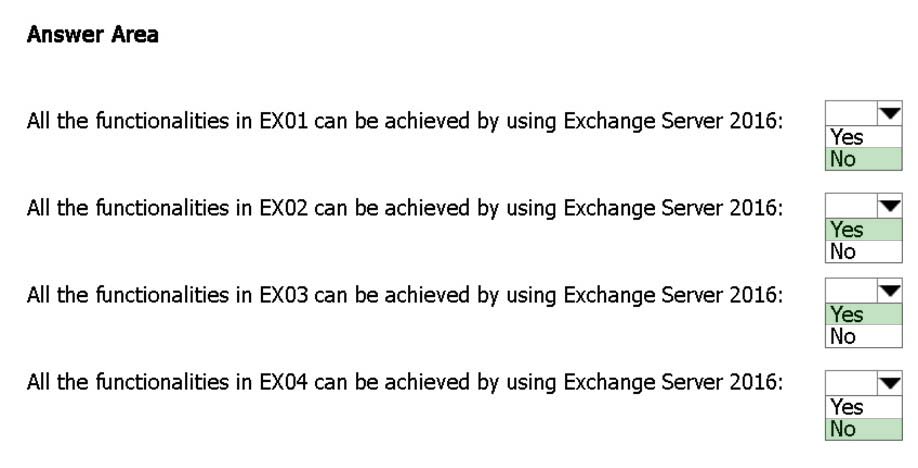
References:
https://technet.microsoft.com/en-us/library/jj619283(v=exchg.160).aspx https://technet.microsoft.com/en-us/library/jj552408(v=exchg.160).aspx

References:
https://technet.microsoft.com/en-us/library/jj619283(v=exchg.160).aspx https://technet.microsoft.com/en-us/library/jj552408(v=exchg.160).aspx
send
light_mode
delete
All Pages

